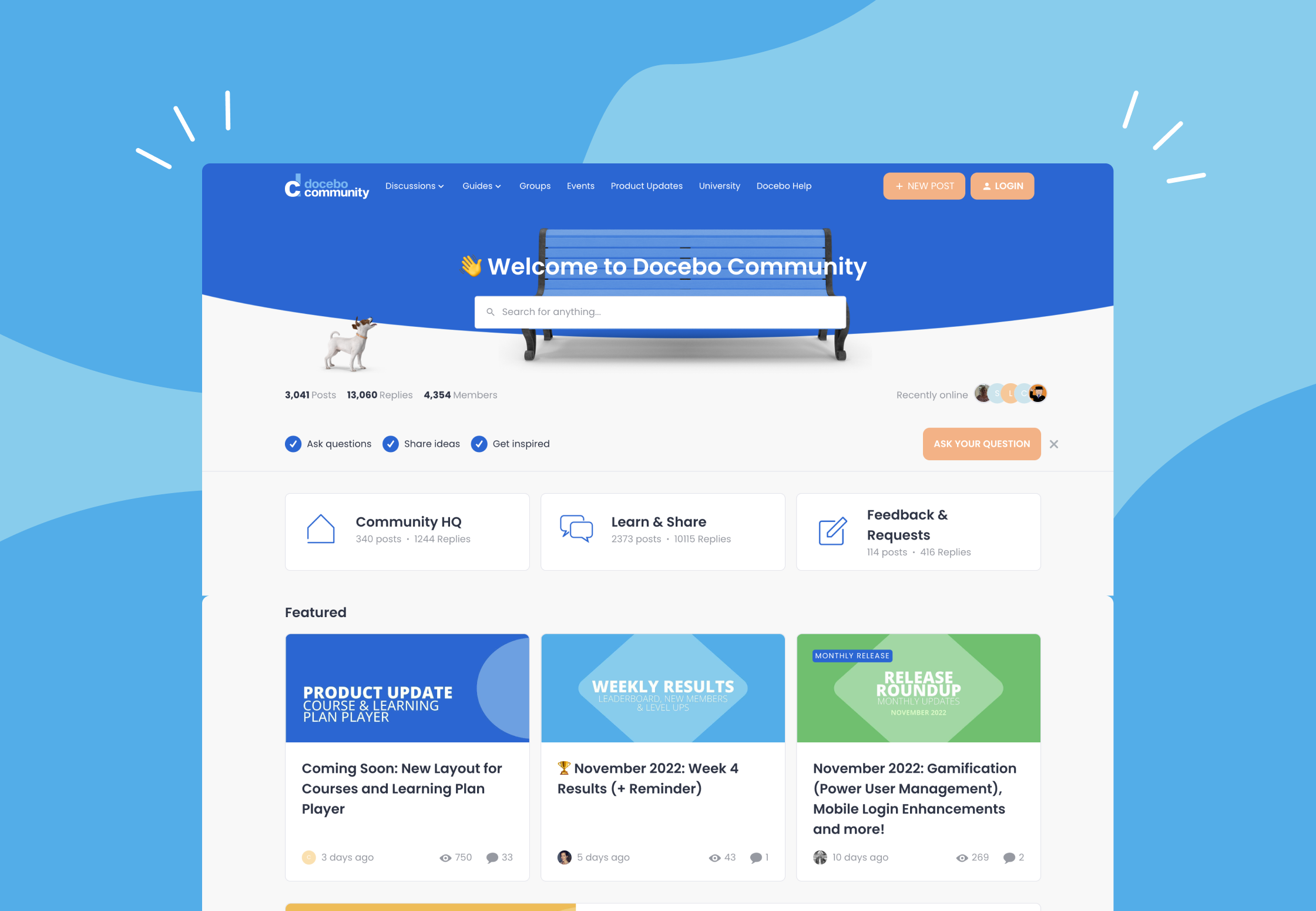
Before global learning technology leader Docebo built the Docebo Community in 2021, its customers were “knocking at the door” for more opportunities to connect with other customers, share best practices, ask questions, and provide product feedback. Whatsapp groups, email threads, and lonely subreddits were allowing customers to find one another here and there, but weren’t quite cutting it. With the help of inSided, Docebo has built a thriving community of over 4,000 members, averaging over 50 new registered users per week in 2022.
Since launching Docebo Community, the learning technology company has improved the way its product team engages with its customers, driven customer engagement through peer-to-peer interaction, expanded its learning culture by encouraging knowledge-sharing and self-service, as well as boosted engagement with other tools like its Knowledgebase (hosted on Zendesk) and their University (built on Docebo). We spoke to Adam Ballhaussen, Senior Director of Customer Education and Advocacy and Erin Brisson, Community Manager at Docebo, about why inSided’s purpose-built community solution was the right tool and what type of results they are seeing.
Expanding on customer education
Though Docebo has achieved incredible results by efficiently scaling their support channels and improving product feedback through the community, they had more than just this success in mind when they decided to dive into community. The learning solutions provider had just launched Docebo University and was looking to enhance the customer experience by bolstering their customer education offering through the power of community, which is where Ballhaussen came into the picture. During his time at cloud-banking software company nCino, he witnessed the power of having a central place where customers could access training, documentation, and share ideas with one another and was ready to implement the same strategy.
“There was a lack of awareness of resources available to our customers and a lack of engagement with a lot of the content that had historically been maintained to train our customers. We saw an opportunity with community as a content strategy to put a heavy focus on product updates and the external customer-facing communication we had around product evolution,” says Ballhaussen. “Building our community on inSided, we were able to use a lot of tools like events, product updates, and specific discussion categories that we could provide our customers so they could become aware of what offerings we have, what content is out there, and also engage directly with us in conversation about those releases.”
With the support from internal stakeholders and the inSided team, it took Ballhaussen only six weeks to get the Docebo community up and running. Ever since, the company has been able to strategically align customer education, advocacy, and product transparency under one customer experience umbrella.
Discovering inSided’s purpose-built solution
When Docebo started its search for the right community vendor, its wishlist of functionality included: the ability to vote on product ideas, easy implementation, an intuitive content structure, and a way for customers to share information about themselves and connect with one another. After compiling a list of 8-9 vendors (including Salesforce, Influitive, and Vanilla) Ballhaussen says the decision didn’t come down to which platform had the most features but the platform that provided the best end-user experience.
Ballhaussen admits he initially gravitated towards a more feature-heavy product like Vanilla that was appealing to him on paper, but during his demos, he realized the amount of administrative workload on the backend and wanted something more streamlined and straightforward.
The team was so focused on finding the perfect fit, that they pivoted from Influitive to give their customer community the most value. “Our customers needed a way to connect with one another and get information from Docebo. We were lacking pretty heavily in our customers’ ability to self-serve,” says Ballhaussen. “An advocacy platform like Influitive is more focused on getting value for Docebo from our customers than our customers getting value on their behalf.”
Ballhaussen says inSided ticked all his boxes and had the right tools to get Docebo Community up and running quickly and provided the expert advice he was looking for.
“InSided is purpose-built for B2B SaaS,” he says. “Throughout the sales process, I felt extremely supported and understood by inSided’s sales team and the experts within the organization. They were community practitioners and experts who were helping advise on our strategy. This helped accelerate our time to value.”
User-generated content and a 96% P2P response rate
In the first six months of the Docebo community going live, 40% of its customers reported they communicated less with Support as a result of their involvement with the community. Customers were getting answers in a more timely manner and had an alternative channel to go beyond Support. Docebo also could tap into a one-to-many approach. “We can answer a question once and it can be surfaced to others,” says Ballhaussen. “The fact that we’re helping two individuals for every person who submits a support ticket is something to be celebrated.”
When Brisson took over the community a year ago, her goal was to continue this momentum and has been doing so with great success. In June of this year, the rate of questions answered by peers in the community hit 96%. This achievement is a testament to the collaborative learning culture that Brisson has built through careful, continuous, and meaningful engagement with community members.
(Aug. 2022 Docebo reached its highest self-service score since launch)
Brisson has also been viewing the amount of user-generated content as an opportunity for Docebo to create longer-form guides based on what she sees garnering a lot of search volume and activity using inSided’s analytics.
“When I first started, ‘notifications’ was our top searched term. So we went out and built a notifications guide that has had over 2,200 views,” she explains.
Docebo averages 300 posts and replies per week from its community. According to Balhaussen, this influx of UGC has not only increased organic search traffic to the community, but also prompted users to weigh in on what they want from Docebo in the future.
Streamlining the product feedback loop
A huge milestone for Docebo has been the launch of its community ideation module back in November 2021. This centralized location for customer feedback and product ideas was incredibly well-received and has seen a whopping 1.8k ideas created, 21k votes, over 1.2k votes delivered, and 30 ideas delivered.
“They’re engaging with our company, they’re engaging with content that’s related to our products, and it’s forcing them to think critically about how they view features within the system,” says Ballhaussen.
While it’s great to see the increase in votes and ideas delivered, the real value is more than these increases. It’s about bringing more transparency and visibility into how we are prioritizing and building products. In addition, bringing ideation into the community has significantly improved the collaboration between customers and our product team.
“As members of Docebo Community, you’re being heard, you’re being listened to, you’re being seen. That’s something that adds a lot of value to the community as well,” says Brisson.
This space for an open dialogue has turned the community into more than just a place for ticket deflection, but into an invaluable network of individuals to connect with.
Driving retention through connections
Docebo knows the value of community goes beyond just one use case and is simultaneously using it for self-service and building customer advocacy.
“Docebo Community has added value for Docebo customers that goes beyond just our products and services. Through the community, our customers can find other like-minded individuals that can help them succeed in their roles. This ecosystem becomes an irreplaceable asset for our customers that helps drive retention and advocacy.” – Adam Ballhaussen, Senior Director of Customer Education and Advocacy
Brisson and Ballhaussen are investing in fostering these relationships and community connections. They’ve doubled the size of the community team by recently bringing on a community moderator to support moderating user-generated content, as well as new content creation. They look forward to making Docebo Community the cornerstone of a number of new advocacy programs that the team plans to introduce in 2023, all while continuing to help serve customers’ needs first and foremost.


